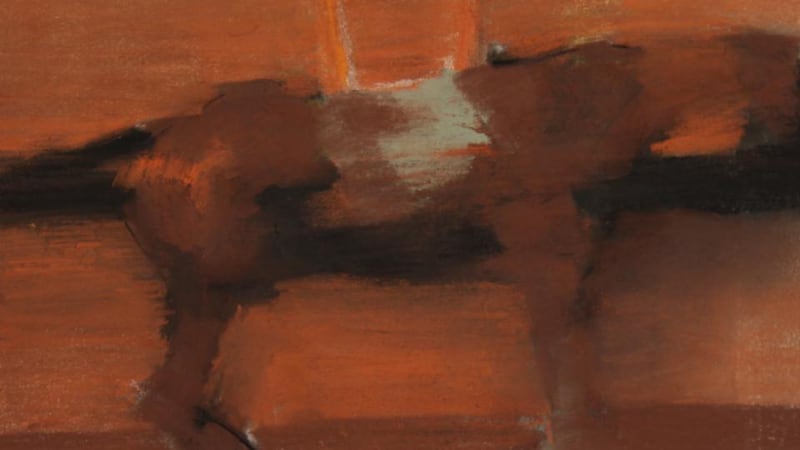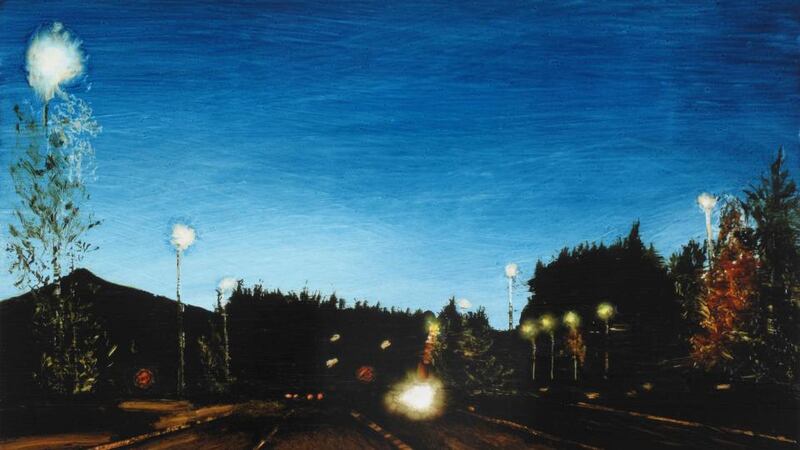Into the Woods – New Work by Gary Coyle
RHA Gallagher Gallery, Dublin
*****


Gary Coyle's Into the Woods is superb. You have to be there in the gallery to get a sense of what he is doing. The exhibition is conceived and delivered as a single, immersive installation. Walk through the door and you have the uncanny sensation of having wandered into a drawing.
That could be because you have wandered into a drawing. Coyle has transformed the gallery into a gothic fantasy, creating a disorienting space that blurs the line between inside and out. The walls are covered by a digital rendering of dense woodland, made on a drawing tablet and printed on vinyl. Yet even as the room opens out to give us imaginative access to a fairy-tale space, we are held back by the fact that pictures hang on the walls. Or rather, black-and-white charcoal drawings of paintings, complete with elaborate, drawn frames hang on the walls, so that the whole thing is like a representation of an 18th-century picture gallery.
Each drawing is densely worked and dark. An explanatory text helpfully details the iconographic make-up. Coyle once, appositely, titled one of his solo shows Southside Gothic. These recent drawings build on his habitual imaginative world in which the gothic is reworked with reference to contemporary cultural idioms, from cult horror thrillers and music to more arcane areas. The explosion depicted in 27/7/1979 The Death of Disco, for example, did take place on the specified date, in the US. It was a bizarre promotional event involving the destruction of a vast crate of disco records, which veered out of control.
Another preoccupation is visibility: what is seen and unseen, the observer and the observed, the unseen observer, the hunter and the prey. In terms of the images, though, what you see is what you get. To his credit, Coyle does not mystify or complicate his work. He just encourages us to look, and to ask ourselves what we are looking at. While he has used photography, documentation, writing and performance, he remains exceptional in placing drawing at the very heart of his work.
[ rhagallery.ieOpens in new window ]
Enclose – Laurence Riddell
Oliver Sears Gallery, Dublin
****
The relationship between humans and horses goes back about 6,000 years and, while the horse has ceded a great deal in terms of its decisive role in the rise and fall of civilisations and states, it retains its exceptional status culturally and emotionally. It’s hardly any wonder, then, that equestrian art has been a constant. There is a shifting border, though, between equestrian art that relates to the equestrian world per se, such as horse breeding, racing and show jumping, and a more considered exploration of the animal and its close human bonds.
Stubbs, Degas, Marini and, closer to home, Olivia Musgrave, are among those artists who have contributed to the latter. So it's brave of Laurence Riddell to set up his stall there. True, his work is grounded in time spent at the heart of the equestrian industry, studying the thoroughbred horse at Kildangan Stud, the Irish Equine Centre and the school of veterinary medicine at UCD. But it's immediately apparent that the horse appeals to him not just as a beautifully built animal but as a sentient being whose predicament, signalled by the word "Enclose", is not only subject to human agency but relevant to our own situation.
Riddell considers the horse as an isolated presence, a condition imposed by human intervention. In cropping the animal's head, he seems to point to a level of disregard, even while noting an appreciation of its athleticism and vitality. He nods to other painters, notably Francis Bacon and Degas, but is always true to his own purposes. He uses colour sparingly but very effectively.
[ oliversearsgallery.comOpens in new window ]
A Slow Stillness Unfolding – Mary-Ruth Walsh
Cross Gallery, Dublin
****
Mary-Ruth Walsh has inventively explored the incongruous overlap between the reality of mass consumer culture and the utopian impulse of modernist planning and design. Her latest work recasts mass-produced packaging of various kinds as idealised architectural drawings. The transposition is remarkably plausible. As she points out, some of the ephemeral packaging she employs is likely to have a longer life than the buildings it impersonates. The ruthless logic of redevelopment in highly prized urban centres outpaces the degeneration of stubbornly durable moulded plastic casing. Essentially part of an ongoing, multifaceted project, it’s a modest show – just six works on paper – but beautifully done and packed with ideas.
[ crossgallery.ieOpens in new window ]
The Longest Road – Oliver Comerford
Kevin Kavanagh Gallery, Dublin
****
In his suite of new small-scale paintings at the Kevin Kavanagh Gallery, Oliver Comerford is back on the road. Culled from numerous photographs taken in transit, the images have an air of pleasurable melancholy. Just as the vantage points situate us between one place and another, in the suspended state of travelling, the hour is usually dusk or dawn, in between light and dark. Despite the luminescence in the sky and flares of electric light close and far, there is little hint of warmth or welcome in the chilly vistas to which Comerford is drawn. Yet an optimism comes through, perhaps an anticipation of arrival or resolution. He is technically adroit, but a certain feeling of deja vu is inevitable if you are at all familiar with his work, perhaps because he’s on the road but not really moving on.

















